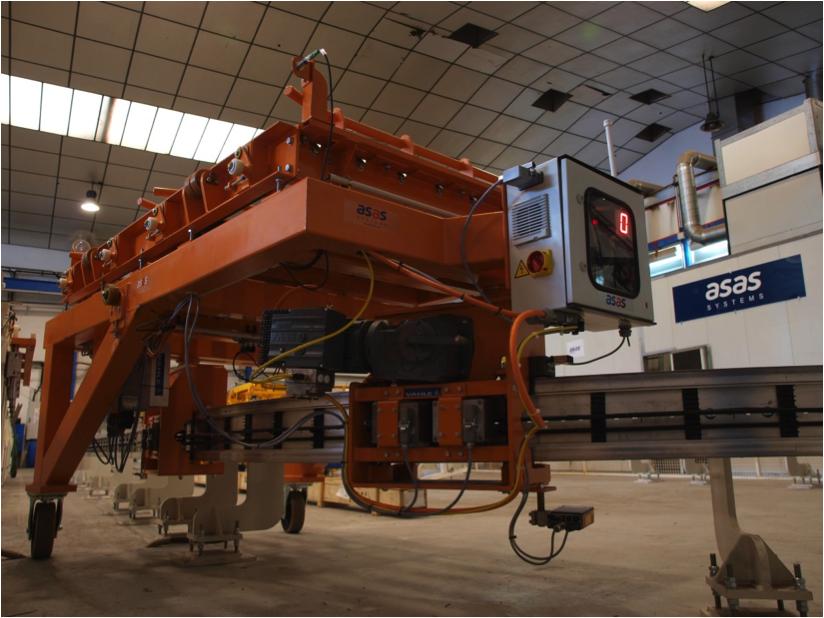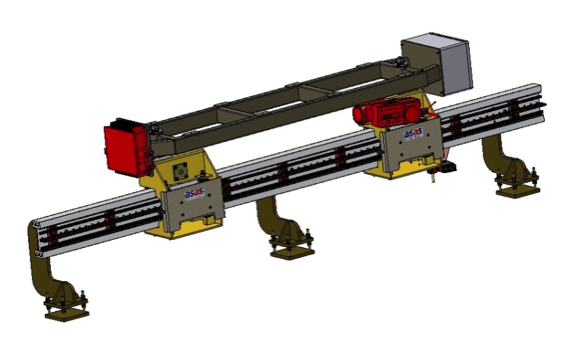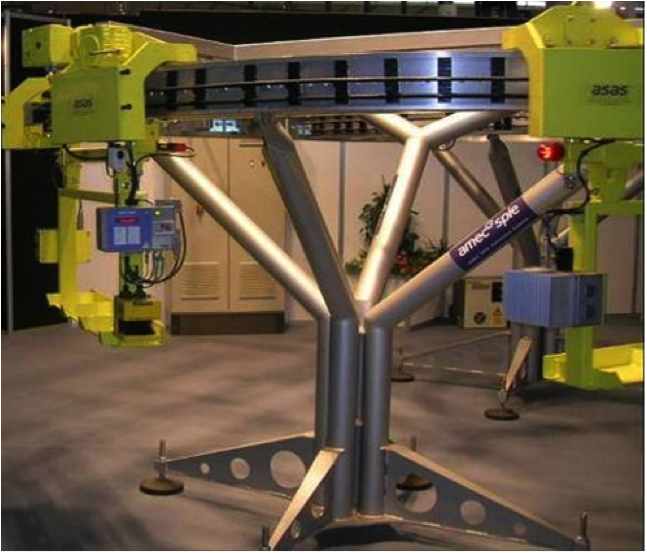

La empresa ISOTRON, perteneciente al Holding ISASTUR, ha detectado que debido al incremento de potencia que están experimentando las actuales plantas fotovoltaicas y los parques eólicos en todo el mundo, se hace necesaria cada vez en mayor número de instalaciones, la incorporación de una subestación elevadora en planta y aguas abajo de la subestación propia de la compañía eléctrica de la zona.
Tradicionalmente, se suelen emplear subestaciones similares a las de la compañía eléctrica, de considerable tamaño y con un gran impacto medioambiental en su construcción. Por el contrario, ISOTRON plantea en este proyecto el desarrollo de una solución modular, más compacta en origen, para las subestaciones elevadoras de las plantas fotovoltaicas y parques eólicos. Este nuevo concepto de subestación eléctrica modular (SEM), que utilizará componentes de tecnologías AIS (Air Insulated Substations), facilitará el montaje en el taller de los elementos que constituyen la subestación, permitiendo un ahorro considerable en costes y tiempo con respecto a una subestación convencional, así como un menor impacto medioambiental en el lugar de destino.
Este proyecto tiene una duración de 14 meses y está parcialmente financiado tanto por el Gobierno del Principado de Asturias a través del IDEPA (Programa Innova-Idepa para el ejercicio 2017) y del Plan de Ciencia y Tecnología (PCTI), como por la Unión Europea a través del FEDER.

ISASTUR, como proveedor de equipos de automatización para la distribución eléctrica, plantea en este proyecto el desarrollo de una nueva solución de telecontrol que incorpore las necesidades de la Industria 4.0 permitiendo la integración de redes de sensores inalámbricos y facilitando la explotación distribuida de los datos del sistema, para en última instancia reducir los tiempos de respuesta y aumentar la eficacia en las labores de soporte de incidencias (fallos de red y reposiciones de servicio de suministro eléctrico).
Propone un nuevo esquema de monitorización de los equipos telecontrolados para la automatización de la distribución en el que se incorporan comunicaciones con dispositivos inalámbricos basados en tecnología LORA, almacenamiento de datos en la nube, monitorización distribuida y aplicaciones software orientadas como servicio para la mejora de las labores de mantenimiento del sistema).
Este proyecto tiene una duración de 24 meses y está parcialmente financiado por el programa de ayudas a la ejecución de proyectos de I+D en el Principado de Asturias para el ejercicio 2016.

REDES2025 project is the biggest joint initiative for the Spanish electrical sector in terms of research, development and innovation, ISASTUR Group is involved in those activities enabling massive integration of renewables in both transport and distribution networks. The main aim of the first of the two subprojects in which ISASTUR Group is participating is the application of power electronics in transport network, and the second subproject is based on the analysis of redox flow technologies for electrical power storage in the control of distribution networks.
For this purpose, a consortium of 45 entities has been built up, led by Red Eléctrica de España, Endesa, Gas Natural Fenosa, HC Energía and Iberdrola, with the coordination support of Tecnalia. Two companies from ISASTUR Group are among the 25 companies (equipment manufacturers and engineering), cooperating with 6 technological centres and research institutes and 9 Universities and Public Research Organizations.
Further information in: http://www.redes2025.com/
Research and development of a new firewall constructive solution, that will comprise fire resistance basic functionality, and will enable lightweight and modular construction as well as erection system which will reduce work on heights. For this purpose a research contract has been settled with Tecnalia Construction Unit, which main contribution will be on its experience and equipment at fire engineering area.
Research and development on information and communication platform that will provide support to:
For this purpose, an international consortium has been built up: Tecnalia (Fundación European Software Institute), Amplía Soluciones, Motorola, Intelligent Sensing Anywhere, Israel Electric Corporation, Universidad de Coimbra, Universidad Carlos III, Honeywell, Vlaamse Instelling voor Technologisch Onderzoek (VITO).
Further information in: http://www.enersip-project.eu/
Development activities oriented to an evolution of SCADA MiniVista©, integrating new advancements of information technologies, both from the industrial and the information society sectors, reinforcing connectivity and personalization capabilities, which will lead to cost reduction, both on commissioning and on exploitation or reconfiguration of production plants.
HC Energía and ISASTUR Group have completed a cooperative research project oriented to the generation of a failure detection system on urban TCs. Research work was oriented to determine how low voltage lines fluctuations are influencing medium voltage, in order to obtain and algorithm that could be implemented in telecontrol equipment.
In the first phase of the project the viability of the research project has been established through the modelization and simulation of a TC, carried out by the research group on Diagnostics of Electrical Machines and Installations of the University of Oviedo. In the second phase of the project these methods have been deeply studied and the results where experienced and validated at a test bench.
Design and Development activities in order to obtain a communication concentrator unit that could smooth the way to the intelligent automation of electrical networks, enabling adoption of IEC61850 to electrical companies, both in new and in existing installations. Besides this, the equipment will provide gateway functionality between Ethernet and point to point or multipoint communication nodes with Rs232 or RS485 standards.
Se trata de un proyecto que da continuidad a una de las líneas de trabajo del proyecto Redes2025, que persigue el desarrollo y demostración de un equipo de almacenamiento de energía eléctrica basado en la tecnología de baterías de flujo redox de vanadio. Es una línea de investigación consolidada para las entidades que participan en el proyecto, que tiene su origen en el seno de las iniciativas de I+D+i que impulsa FUTURED (Plataforma tecnológica española de redes eléctricas).
Redox2015 es un proyecto de 3 años de duración (2011-2013) que está liderado por HC Energía y cuenta con la participación de ISASTUR y ZIGOR, así como otras cinco entidades de investigación, como son la Universidad de Oviedo, INCAR-CSIC, IREC, TECNALIA y TEKNIKER.
El proyecto ha contado con un presupuesto de 2 millones de euros y ha sido financiado parcialmente por el Ministerio de Economía y Competitividad (como parte del Plan Nacional de Investigación Científica, Desarrollo e Innovación Tecnológica), así como cofinanciado con fondos FEDER a través de la convocatoria INNPACTO 2011 (IPT-2011-1690-920000).
Más información en: http://www.sostenibilidadedp.es/pages/index/proyecto-redox-2015

El proyecto hCODA persigue, como objetivo general, el desarrollo de un sistema capaz de integrar la información proveniente de ámbitos tradicionalmente separados, como son el telecontrol y la telemedida, en un único punto, contribuyendo a la automatización de la red de baja tensión. Se ha desarrollado un equipo concentrador capaz de gestionar distintos tipos de información llevando a cabo las funciones de:
El proyecto tuvo una duración de 14 meses y ha sido financiado parcialmente por el programa Innova-IDEPA, del Gobierno del Principado de Asturias, así como cofinanciado al 80% con fondos FEDER.

Este proyecto forma parte del desarrollo de nuevos productos para las redes eléctricas inteligentes a partir del movimiento de hardware libre. El objetivo principal es aplicar tarjetas (SoB) y módulos (SoC) brindados como hardware abierto o libre, así como herramientas de software libre, como base del diseño de un equipo clave: el concentrador de medidas, nodo de comunicaciones entre la red de contadores y el operador de la red eléctrica.
El proyecto tiene una duración de 18 meses y está financiado parcialmente por el programa INNOVA IDEPA, del Gobierno del Principado de Asturias, así como cofinanciado con fondos europeos FEDER.

Demonstration project of a new sustainable biodiesel production scheme integrating an on-site by-products energy valorisation jointly with other complementary organic wastes from food industry and catering activities. The system integrates two energy technologies:
For this purpose, a consortium has been built up with the participation of: Ania Technological Centre Fundación Cidaut, Bionorte (participated by ISASTUR Group), BioGas Fuel Cell.
Further information in: http://www.integral-b.com/
During this firs stage, activities have been oriented to state of the art and screening of components of building integrated photovoltaic installations, and the adaptation of ACATIVE © remote control series to conventional monitoring of photovoltaic installations. This phase has also been oriented to drawing next phases of research and development of a complete system of diagnostics and optimization of failures on this type of installations, based on the behaviour of the individual panels.
Research and Development of a system for diagnosis and optimization of failures and underperformance of building integrated photovoltaic installations, based on the analisys of individualised modules. The concept is coming from conventional photovoltaics, in which accessible data aggregates data coming from strings of panels. In order to obtain an innovative system, the project will analyze the individual performance of the panels on different working conditions typical of BIPV, formulating new supervision algorithms, diagnosis and optimization of the installation overall performace. For this purpose a research contract has been settled with Tecnalia Energy Unit, which accumulates significant experience from several research projects both at international level in the field of fault detection and prediction on inverter-based distributed architecture of PV installations.
Living Car Asturias initiative is an open experimental project that enables research on electrical mobility as a new concept of mobility in a real environment with real users.
The project does not limit its scope to the infrastructures that will be needed for recharging the electrical vehicules, but also considers the vehicle, the user and the rest of the citizens.
Living Car is a member of ENOLL (ENOLL (European Networt of Living Labs) and is an example of public private partner ship.
Searching for cooperation profiles of companies or labs with experience on extracting oil from microalgae.
El objetivo general del proyecto es el diseño y desarrollo de una aplicación software para facilitar la optimización de posicionamiento de los elementos que determinan conexión de los paneles con cajas, inversores y punto de conexión en una planta de generación fotovoltaica, buscando al mismo tiempo, diseño optimizado de la red de cableado que minimice el coste ejecutivo.
Las normativas de IEC, CIM (Common Information Model), la legislación vigente, las reglamentaciones específicas de cada país y las condiciones técnicas y contractuales, enmarcan el diseño de un serie de algoritmos de tipo heurístico y metaheurístico que, aplicados sobre el diseño de una planta de generación permitirán determinar la mejor distribución posible de las cadenas (strings) de paneles y cableado hasta las cajas de conexión y los inversores.
Con los resultados del proyecto, ISOTRON dispondrá de una herramienta con la que realizar el diseño de forma más rápida y eficiente, reduciendo con ello los costes de ingeniería al mismo tiempo que permitirá reducir los costes de cableado, y minimizar desviaciones en la fase de construcción.
Este proyecto tiene una duración de 28 meses y está parcialmente financiado tanto por el Gobierno del Principado de Asturias a través del IDEPA, en el marco de la Estrategia Asturias RIS3 para el ejercicio 2020, y del Plan de Ciencia, Tecnología e Innovación (PCTI), como por Unión europea, a través del Fondo Europeo de Desarrollo Regional (FEDER), PROGRAMA OPERATIVO FONDO EUROPEO DE DESARROLLO REGIONAL DE ASTURIAS 2014-2020.

El objetivo del proyecto es el diseño y desarrollo de un sistema de Control de Planta Fotovoltaica Extendido, integrando los elementos de la conexión a red bajo el paradigma internet industrial de las cosas. Como resultados se obtendrá, por un lado, un conjunto de estrategias de gestión del flujo de energía eléctrica para el cumplimiento de los requerimientos de inyección de la planta en el punto de conexión (rampas de potencia o actuación de acuerdo a un perfil predefinido), y por otro su implementación en el sistema de Control de Planta Extendido.
Este proyecto tiene una duración de 15 meses y está parcialmente financiado tanto por el Gobierno del Principado de Asturias a través del IDEPA, en el marco de la Estrategia Asturias RIS3 para el ejercicio 2019, y del Plan de Ciencia, Tecnología e Innovación (PCTI), como por Unión europea, a través del Fondo Europeo de Desarrollo Regional (FEDER), PROGRAMA OPERATIVO FONDO EUROPEO DE DESARROLLO REGIONAL DE ASTURIAS 2014-2020.

Research and development activities that would lead to a new automatic system for monitoring coke temperature, based on applying artificial vision technologies to thermographical images processing.
During this first stage of the Project, the most outstanding results are the capability of importing configuration data from 61850 standard to local supervision, open modules for report building and database selection.
Research on modelling and automation of the generation of the intranet applications which are the Integral Management Framework of Isasur Group.
Development of an intelligent tutorial system based on interactive virtual environments (IVEs) with simulation of facilities which present high electrical risk, particularly, high voltage electrical substations.
Analysis of the viability of incorporating radiofrequency technologies such as RFID, UWB or WiFi for improving safety in the identification of individual protective equipment and in the localization of personnel in hostile industrial environments (iron and steel, high voltage).
Searching for cooperation profiles of companies with pre- commercial prototypes or experience on development of robotic devices for life assistance.

Self-propelled trolley on inverted electric monorail powered by induction with an on-board conveyor with the following features:

Self-propelled trolley on inverted electric monorail powered by induction with on-board equipment with the following features:

Transport system with self-propelled trolley on overhead induction-powered electrical monorail with the following features:
This project lies within the general framework of promoting sustainable mobility; more specifically, with a view to contributing to "traffic calming" and has consisted in the development of a new type of speed bump. The speed bump developed only deploys in certain situations (e.g. excessive speed) and can detect emergency services. In addition, its remote control features can facilitate, among other aspects, the coordination of a series of speed bumps.
The prototype complies with the following requirements: It can be used with all types of light and heavy vehicles that circulate in urban environments; maximum speed of 50km/h; shape and dimensions similar to a conventional speed bump; in its normal position, the speed bump is retracted and does not interfere with traffic; remote control and management of the speed bump's position (retracted or deployed) and, finally, it requires minimal installation work.
The project lasted 12 months and was funded in part through the Innova-IDEPA programme of the Government of the Principality of Asturias and with ERDF funds.

Los objetivos principales de este proyecto son estudiar las condiciones y técnicas de tratamiento y preparación de residuos para obtener combustibles alternativos (CDR/CSR) a partir de residuos domésticos y residuos industriales no peligrosos de Asturias.
Investigar las especificaciones requeridas para valorizar CDR/CSR en La Pereda, así como las adaptaciones necesarias en dicha central para que pueda utilizar CDR/CSR como combustible alternativo al carbón de forma rutinaria. Paralelamente, en el plano de la valorización química, el proyecto estudia las distintas opciones tecnológicas para facilitar las decisiones en cuanto a viabilidad técnica y económica en el medio-largo plazo.
Para la ejecución de este proyecto de 22 meses de duración se ha formado un consorcio con HULLERAS DEL NORTE, COGERSA, CALDERERÍA, REPARACIONES Y PROYECTOS DEL NORTE y DANIEL G. RIESTRA. Está parcialmente financiado por el programa de ayudas a proyectos de I+D+i diferenciales o tractores desarrollados por empresas del Principado de Asturias para el ejercicio 2017.
